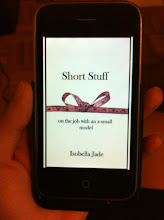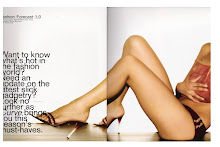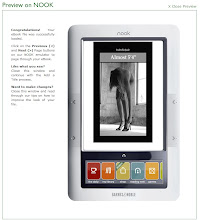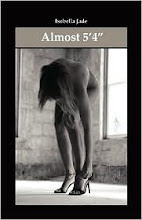I have been featuring lately a lot of ad campaigns that show unique models, and that show that a model isn't always tall and thin. I found this article about thin models and how they don't make woman feel good about themselves, in Adage, very interesting.
Researchers Find Thin Models Make Viewers Like Brands More, but Themselves LessBy Jack Neff
Published: July 30, 2008
BATAVIA, Ohio (AdAge.com) -- Thin is still in for advertising, new research suggests, unless you're trying to sell cookies or self-esteem.
Women who had just seen thin models were nearly four times more likelyto turn down a snack pack of Oreo cookies offered as thanks for their participation in the study than women who hadn't.
A study by business professors at Villanova University and the College of New Jersey, inspired by Dove's "Campaign for Real Beauty," shows that ads featuring thin models made women feel worse about themselves but better about the brands featured.
Seeing thin models also made college-age women far more likely to turn down a snack pack of Oreo cookies offered as thanks for their participation in the study, or to opt for a reduced-fat version. Women who had just seen thin models were nearly four times more likely to say no to Oreos than women who hadn't, and 42% more likely to opt for reduced-fat cookies if they did indulge.
Women in a sample of 194 college students aged 18-24 expressed more negative feelings about their sexual attractiveness, weight and physical condition after seeing thin models than before. So-called high self-monitoring women, or those more concerned about what others think of their appearance, were the most negatively affected by seeing the thin models in the study.
More likely to buy
The professors are still preparing a written report on results from a second phase of the research, which found that despite the negative effect on their body image, women preferred ads showing thin models and said they were more likely to buy products featured in those ads than in ones showing "regular-size models," said Jeremy Kees, a business professor at Villanova.
Karen Becker-Olsen, a business professor at the College of New Jersey, also has been conducting the research. She couldn't be reached for comment by deadline.
"The really interesting result we're seeing across multiple studies is that these thin models make women feel bad, but they like it," Mr. Kees said. "They have higher evaluation of the brands. With the more regular-size models, they don't feel bad. Their body image doesn't change. But in terms of evaluations of the brands, those are actually lower."
Mr. Kees acknowledged the findings create something of a quandary for marketers, who might have a positive effect on young women's self-esteem by showing more typical women in ads, but suffer in the marketplace as a result.
"I'd tend to be cautious about using models in advertising that wouldn't maximize the attitudes and evaluations of the advertising and the brands," he said. "Certainly [Dove is] getting a lot of publicity, and it's a great, innovative campaign. But in terms of the bottom line of how that might be impacting ... purchase behavior, I'm not sure."
Appetite suppressant
Mr. Kees said the professors landed on the Oreo tactic, in which study participants didn't know their post-ad-exposure cookie-eating would be monitored, as a way of studying real behavioral impact in addition to the usual survey responses regarding ads. The Dove Self-Esteem Fund, backed by its Campaign for Real Beauty, has exceeded its original goal of reaching 1 million young girls by this year and expanded its target to 5 million by 2010.
The data shows a definite, if short-term, link between thin models in ads and eating behavior, but Mr. Kees said he wasn't comfortable making the leap that seeing thin models could cause eating disorders.
Dove and its agency, Ogilvy & Mather, Toronto, weren't reluctant to connect those dots in their "Onslaught" viral video released last year, splicing scenes of yo-yo dieting and bulimia into a montage of beauty advertising.
"That's a far stretch to infer an eating disorder from a one-time choice," Mr. Kees said, but added, "That's certainly a scenario that would be rich for future research."
The new study in part concurs with and in part diverges from some prior research on the impact of thin models. Research reported in 2005 and 2006 from psychology professors at University of Sussex and University of West England in the U.K. concluded that ads featuring ultra-thin models do make women feel worse about their looks, but aren't any better at selling products than ads featuring more typically proportioned women.
The Lower Chamber of France's Parliament earlier this year passed a law that would ban the use of ultra-thin models in ads, and authorities in Spain last year banned ultra-thin models from runways. Unilever also vowed to not use size-zero models in any of its advertising.
Unilever stays the course
In a statement, a spokesman for Unilever said the company believes its approach works. "Unilever is confident in the effectiveness of its advertising," he said. "We believe women have the right to feel comfortable with their bodies and not suffer from lack of self-esteem brought on by images of excessive slimness."
Dove's campaign, he said, has "penetrated society and started a dialog about real beauty," adding that "we are thrilled by the overwhelming positive responses we have received from women (and men) as a result of the campaign."
The Dove Self-Esteem Fund, backed by the campaign, has exceeded its original goal of reaching 1 million young girls by this year and expanded its target to 5 million by 2010. Campaignforrealbeauty.com, he said, already has reached 4.5 million people.
Despite those efforts, he said, "There is no question that women and young girls are being bombarded with unrealistic messages and images of beauty that impact their self-esteem." But, he said, "We are excited to see now (and have seen in the past couple of years) a growing trend towards more realistic and healthy looking women in advertising and in the media."
Thursday, July 31, 2008
Subscribe to:
Post Comments (Atom)











+copy.jpg)








1 comment:
It's so many years later and I still come across this Isobella- I found this when I googled myself years ago and I read it every once in a while. Thanks again for posting!
Post a Comment